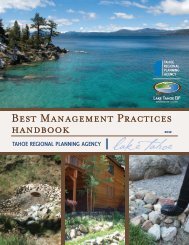4.4-g HYDRODYNAMIC SEPARATOR DESCRIPTION ... - Tahoe BMP
4.4-g HYDRODYNAMIC SEPARATOR DESCRIPTION ... - Tahoe BMP
4.4-g HYDRODYNAMIC SEPARATOR DESCRIPTION ... - Tahoe BMP
You also want an ePaper? Increase the reach of your titles
YUMPU automatically turns print PDFs into web optimized ePapers that Google loves.
<strong>4.4</strong>-g<br />
<strong>HYDRODYNAMIC</strong> <strong>SEPARATOR</strong><br />
Alternative Names: Vortex Separators, Swirl Concentrators<br />
<strong>DESCRIPTION</strong><br />
Hydrodynamic separators remove trash, debris, and some sediment, oil, and grease<br />
from stormwater runoff. The units are designed to swirl stormwater in a circular<br />
motion, using centrifugal forces to separate and collect heavier pollutants that<br />
move to the center of the device where they settle to the bottom. Trash, oil, grease,<br />
and other floatable debris are retained in the device with a baffle system.<br />
<strong>BMP</strong> DESIGN APPROACH<br />
Pollutant Source<br />
Control<br />
Hydrologic Source<br />
Control<br />
Stormwater<br />
Treatment<br />
SCALE OF APPLICATION<br />
All SFR and MFR < 1<br />
acre<br />
MFR 1-5 Acre and<br />
CICU < 5 acres<br />
MFR and CICU > 5<br />
acres and all WQIPs<br />
TYPE OF APPLICATION<br />
Temporary<br />
Permanent<br />
APPLICABILITY<br />
• Typically applied as a pretreatment device to remove coarse sediment, trash,<br />
and other debris from stormwater runoff.<br />
• Certain designs can be installed anywhere that a standard manhole can be<br />
installed.<br />
• Connected to an existing or proposed storm drainage system.<br />
• Not considered effective for removal of pollutants of concern for lake clarity.<br />
Advantages<br />
• Useful for retrofit applications to provide additional stormwater treatment.<br />
• When considering the small space requirements of these devices, they are<br />
relatively effective for removal of trash, debris, and coarse sediment.<br />
• Most designs do not require confined space entry for cleanout and<br />
maintenance.<br />
TRPA <strong>BMP</strong> Handbook<br />
May 2014<br />
Chapter 4: <strong>BMP</strong> Toolkit<br />
<strong>4.4</strong>-g Hydrodynamic Separator<br />
Page 37
• Individual units can be placed in series to provide additional storage capacity<br />
for captured material.<br />
Disadvantages<br />
• Typically requires frequent maintenance to remove captured material to<br />
avoid re-suspension and transport during subsequent runoff events.<br />
• Cannot remove significant amounts of pollutants of concern for lake clarity<br />
(i.e. fine sediment particles and species of nitrogen and phosphorus).<br />
• Units with standing water potentially promote mosquito breeding.<br />
DESIGN CONSIDERATIONS<br />
The following guidelines are water quality design considerations. Refer to<br />
applicable drainage design manuals within the responsible jurisdiction for<br />
requirements associated with structural integrity, drainage design, public safety,<br />
and other factors.<br />
• Size units based on manufacturer’s design criteria and guidelines.<br />
• Ensure the unit selected is effective at removal of targeted pollutants.<br />
• Ensure that the peak flow of the design storm event targeted is matched by the<br />
treatment flow capacity of the unit, not the hydraulic capacity of the unit.<br />
• Consider hydraulic head loss in the design, which differs by product and model.<br />
• Eliminate access openings to the extent possible for adult mosquitoes.<br />
• Install oil adsorbent materials to capture oil and grease.<br />
INSTALLATION CONSIDERATIONS<br />
Refer to manufacturer’s instructions for proper installation guidelines.<br />
INSPECTION AND MAINTENANCE<br />
• Inspect at least twice per year and after significant runoff events.<br />
• Use <strong>BMP</strong> Rapid Assessment Methodology (RAM) protocols pertaining to<br />
treatment vaults to establish benchmark and threshold standard criteria for<br />
maintenance and material removal.<br />
• Use a stadia rod to measure the amount of accumulated sediment and material<br />
in the device.<br />
• Most units are designed to be cleaned by a vactor truck or functionally<br />
equivalent equipment.<br />
• Properly dispose of material and standing water.<br />
EFFECTIVENESS CONSIDERATIONS<br />
Hydrodynamic separators can be effective at removing coarse sediment and debris<br />
when properly designed, constructed, and maintained. Hydrodynamic separators<br />
are not considered effective for removal of pollutants of concern for lake clarity<br />
(fine sediment particles and species of nitrogen and phosphorus). Hydrodynamic<br />
separators, when properly maintained, can be successful pretreatment devices that<br />
increase the effectiveness of downstream <strong>BMP</strong>s by reducing loads of coarse<br />
sediment and other gross pollutants.<br />
Chapter 4: <strong>BMP</strong> Toolkit<br />
TRPA <strong>BMP</strong> Handbook<br />
<strong>4.4</strong>-g Hydrodynamic Separator May 2014<br />
Page 38
















